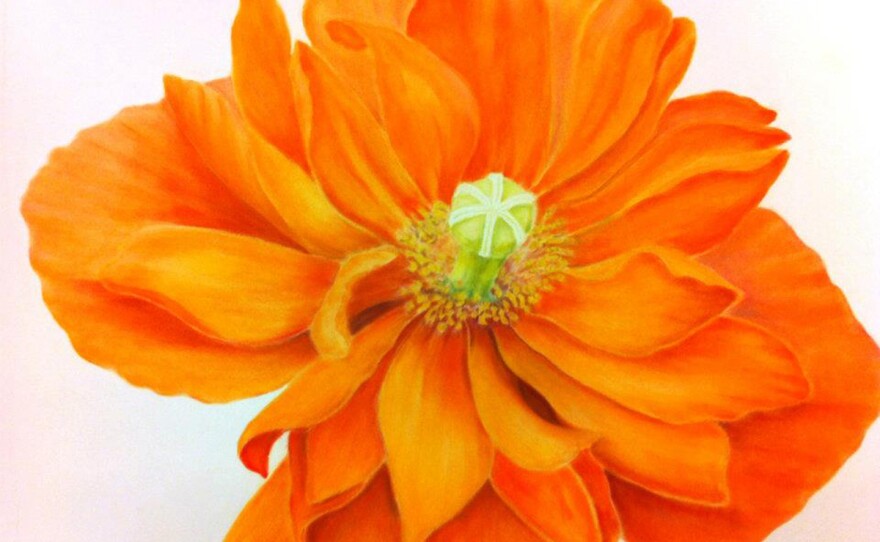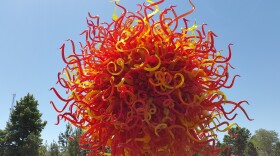A sprig of dried rose hips sits atop Nels Broste's drafting table, in a classroom inside the Denver Botanic Gardens. Broste has drawn an outline on the paper in front of him, and flips back and forth between sheets of tracing paper as he tries to perfect his composition.
Connie Sayas, his instructor, walks up with some encouragement and a few tips.
"So what I like is these interesting shapes, so if this was your paper, we've got this nice jagged edge here," said Sayas.
"I also like the balance between the different textures, so we know that these rose hips are crinkled up, it will be a really nice contrast. So you want to push those textures."
Broste is not an artist by training -- he's a retired engineer -- but his sketch is spot on. He recently earned a certificate from the Denver Botanic Gardens School of Botanical Art and Illustration. He's taking this extra class, "for the fun of it."
Broste is one of about 500 students at the school, which is the oldest of its kind in the country, said director Mervi Hjelmroos-Koski. The school's first class was offered in 1979. It began granting certificates in 1990, and now offers 170 different classes.
"Which means we teach basically from 9 a.m. to 9 p.m. every day," she said.
You'd be forgiven if you thought the ancient art of botanical illustration, common during the 17th and 18th centuries, as explorers brought home plant specimens from around the world and wanted to capture them in detail, had fallen off with the advent of the photograph.
While there was a slowdown in the art, there's been a recent resurgence. The American Society of Botanical Artists celebrated its 30th anniversary in 2014, and continues to grow. There's a continued need for these skills, said Hjelmroos-Koski, because a good illustration can show much more than the best snapshot. In science, that's important.
"In an illustration, you can portray every single part of the illustration in focus," she said. "You can portray the whole entire plant, with roots, and stem, and leaves, and flowers, wilted flowers, and seeds, everything in the same plant, which is not often possible in a photograph."
She continues with, perhaps, the ultimate backhanded compliment: "Digital photos are a very great support, and they have a great value there -- but the photograph is lying."
Botanical illustrations are used today in encyclopedias, field guides, textbooks, academic journals, museum exhibits -- even children's books. Program graduates go on to careers in all these areas, said Hjemlroos-Koski

Back in Sayas' class, called "Dried With Drama," because it focuses on illustrating dried plants from the winter months, the instructor is helping students "play with" colors.
"There's something called complementary colors on the color wheel; they are opposite each other on the color wheel. So for instance you can take a purple and a yellow, and mix them together, and you can make sort of a tan color, but it will be really colorful and fused with the purples in it," she said.
Even though Sayas has been illustrating for decades -- she had a career as a museum exhibit designer and illustrated for Encyclopedia Britannica, "it's always magical," she said.
"Especially when you are putting paint onto wet paper, there's always sort of this unexpected factor. It makes it frightening, but it also makes it exciting."
Sayas' students come from a wide range of backgrounds, artistic and not.

"We can teach anybody to draw," she said. "The backgrounds vary but you get a lot of people with gardening interests, scientific interests, artistic interests, but we're all fascinated by the plants we portray. "
As class continues, another student, Mary McCauley, who works as a fiber artist, composes an illustration of giant, dead, curling leaves. What she learns in classes, said McCauley, inspires her own art.
"For me, the number one thing I have learned in this program is really how to look again, really how to observe and see what is there," she said. "Not what you expect to see or want to see. You really have to look. I see color completely differently now."
Looking at the leaves she was painting, McCauley laughed.
"I think they are more interesting when they are -- we were laughing about it -- diseased, deformed, or dead."
The courses aren't just the standard drawing, pen and ink, or painting. There are classes in silk embroidery, calligraphy -- and, of course, botany, led by Hjelmroos-Koski, whose background is in plant science.
"Take some of Mervi's biology classes where you take a flower apart and look at all the pieces and parts of it and you say, 'wow, it's really amazing,'" added Broste.
As he continues working on getting the rose hip scene composed just so, Broste says that even though it's a slow process, he enjoys showing off his final product.
"I guess the best part is, finally, when I get done, and someone says, 'hey, that's a neat picture,'" he said. "It isn't abstract art or anything like that. It's kind of real to people."
You can view even more images from the school online at their Facebook page.














